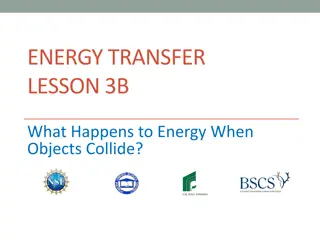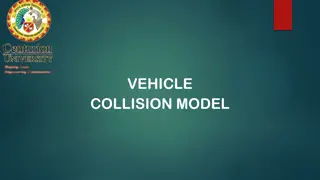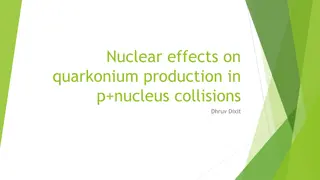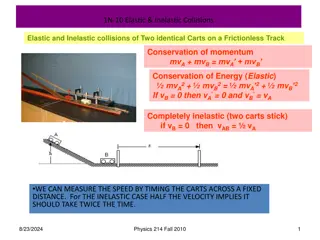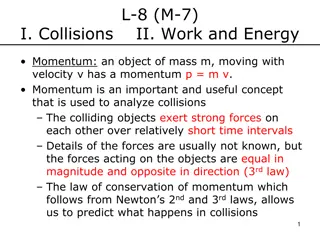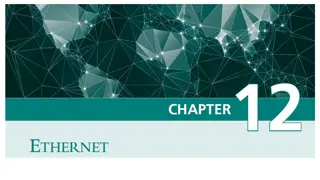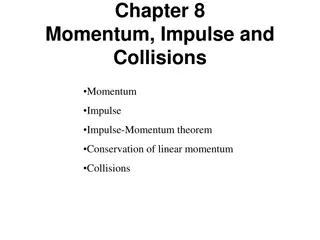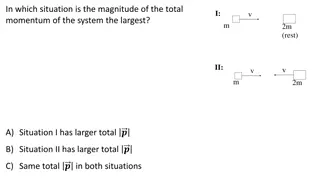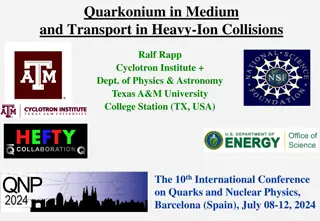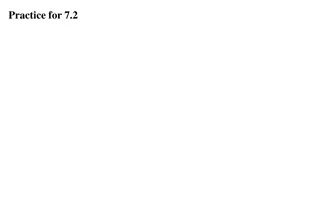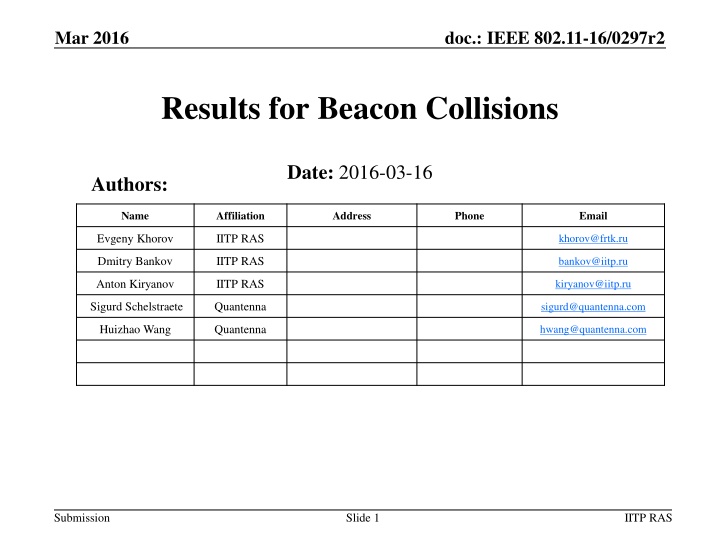
IEEE 802.11-16/0297r2 Results: Beacon Collisions in Simulation Scenarios
Explore the findings from the IEEE 802.11-16/0297r2 study on beacon collisions in residential scenarios. Understand the time, channel, and location conditions contributing to beacon collisions between APs and STAs. Dive into the analysis of beacon overlap in time and the impact on signal reception. Discover insights on beacon collision avoidance mechanisms proposed and validated through simulations.
Download Presentation

Please find below an Image/Link to download the presentation.
The content on the website is provided AS IS for your information and personal use only. It may not be sold, licensed, or shared on other websites without obtaining consent from the author. If you encounter any issues during the download, it is possible that the publisher has removed the file from their server.
You are allowed to download the files provided on this website for personal or commercial use, subject to the condition that they are used lawfully. All files are the property of their respective owners.
The content on the website is provided AS IS for your information and personal use only. It may not be sold, licensed, or shared on other websites without obtaining consent from the author.
E N D
Presentation Transcript
Mar 2016 doc.: IEEE 802.11-16/0297r2 Results for Beacon Collisions Date: 2016-03-16 Authors: Name Affiliation Address Phone Email Evgeny Khorov IITP RAS khorov@frtk.ru Dmitry Bankov IITP RAS bankov@iitp.ru Anton Kiryanov IITP RAS kiryanov@iitp.ru Sigurd Schelstraete Quantenna sigurd@quantenna.com Huizhao Wang Quantenna hwang@quantenna.com Submission Slide 1 IITP RAS
Mar 2016 doc.: IEEE 802.11-16/0297r2 Motivation At Jan 16 meeting we have proposed the beacon collision avoidance mechanism [1] The feedback from the group: The problem existence shall be proved in simulation scenarios [2] Submission Slide 2 IITP RAS
Mar 2016 doc.: IEEE 802.11-16/0297r2 Residential Scenario 10flats in a row 5floors 2rows Submission Slide 3 IITP RAS
Mar 2016 doc.: IEEE 802.11-16/0297r2 Path Loss Model ?? 2.4+ 20 log10min ?,5 + ?+2 ?+1 0.46 + 5 ? ?? ? = 40.05 + 20 log10 ? 5+ 18.3 ? ? > 5 35 log10 W: number of walls traversed in x-direction plus number of walls traversed in y-direction F: number of floors traversed fc: frequency [GHz] d: distance [m] d Submission Slide 4 IITP RAS
Mar 2016 doc.: IEEE 802.11-16/0297r2 Beacon Collisions Beacon collision is collision at a STA between a beacon from its own AP and a beacon from an alien AP. It occurs when all the following conditions are met: Time condition: beacons overlap in time Channel condition: both APs send beacons in the same channel Location condition: the STA receives an alien beacon, while its own AP does not. Submission Slide 5 IITP RAS
Mar 2016 doc.: IEEE 802.11-16/0297r2 Time Condition (1/3) Time condition: beacons overlap in time The signal from its own AP is typically much higher than the signal from an alien AP (located in another flat). If the intra-BSS beacon (beacon from STA s own AP) starts earlier, the alien beacon is just a small noise and cannot damage intra-BSS beacon. If the alien beacon starts earlier, the STA starts receiving this beacon and does not sync at the intra-BSS beacon. In our analysis we consider time condition: Beacons overlap in time, and an alien beacon starts earlier than an intra-BSS beacon (preamble duration is neglected). Intra-BSS beacon Alien beacon Submission Slide 6 IITP RAS
Mar 2016 doc.: IEEE 802.11-16/0297r2 Time Condition (2/3) What is the probability for a STA that a beacon from one hidden AP overlaps with its own AP s beacon and alien beacon starts earlier? Assuming that beacon duration is 500 us and BI=500 ms, i.e. BI is 1000 longer, we obtain that for one hidden AP the probability of time condition is 0.1%. Since AP transmits data packets in addition to beacons, the probability that a beacon is damaged increases. For how long will beacons collide? While the standard states that the clock drifting shall be less than 100ppm, in real devices it is less than 10ppm. If the clock drifting of the APs is in opposite directions and it is 10 ppm (relative drifting is 20ppm), beacons will collide for 25 seconds. Note that constant clock drifting in opposite directions is the best case. In fact, the clock drifting is a random process, so beacons will collide for much longer time. Such continuous beacon collisions can cause disassociation from the AP. Slide 7 Submission IITP RAS
Mar 2016 doc.: IEEE 802.11-16/0297r2 Time Condition (3/3) The probability that beacons of two APs overlap in time is small, however because of clock drifting sooner or later the problem arises. Relative Clock Drifting 1 ppm 5 ppm 10 ppm 20 ppm Collision Duration ~ 8 min ~1.5 min 50 s 25 s Collision Period ~ 6 days ~1 day 14 hours 7 hours * Beacon interval = 500 ms, duration = 500 us (collision probability = 0.1%) Even probability of 0.1% can cause inexplicable occasional malfunction, which may make users continuously reboot the AP. Different beacon intervals cannot solve the problem, since APs transmit data packets in addition to beacons. Submission Slide 8 IITP RAS
Mar 2016 doc.: IEEE 802.11-16/0297r2 Channel Condition In 2.4 GHz, there are 3 non-overlapping 20 MHz channels. In 5 GHz there are more than 20 non-overlapping 20 MHz channels TGax Simulation Scenarios document considers 3 or 5 80MHz non- overlapping channels, with random selection of primary channel per operating channel , i.e. 9 or 15 non-overlapping primary-20 channels. Note. In real situation, if two APs are hidden from each other (our case!), they are more likely to select the same channel, rather than if they are direct neighbors. Submission Slide 9 IITP RAS
Mar 2016 doc.: IEEE 802.11-16/0297r2 Location Condition Beacon collision is possible, if the STA hears the beacons from an alien AP, while its own AP does not ???= 18 ??? d1 AP ?? ? ????= ??? ??(?1) STA ???= ??? ??(?2) d2 Location Condition: ???< ?? ?< ???? AP Submission Slide 10 IITP RAS
Mar 2016 doc.: IEEE 802.11-16/0297r2 Beacon Collision Location Condition Beacon collision is possible, if the STA hears the beacons from an alien AP, while its own AP does not. d1 AP ? Taking into account fading and different antenna gain STA d2 ???< ?? ? ????> ?? ?+ ? AP Submission Slide 11 IITP RAS
Mar 2016 doc.: IEEE 802.11-16/0297r2 Locations of STAs and APs in the Flats Possible STA locations AP Submission Slide 12 IITP RAS
Mar 2016 doc.: IEEE 802.11-16/0297r2 Number of Hidden APs for Which Location Condition is Met in a Non-edge Flat With APs in the Center ? = 0 ?? ?= 86 ??? AP Killing APs are located in 4 flats, which is more than the number of 20 MHz channels in 2.4 GHz Submission IITP RAS Slide 13
Mar 2016 doc.: IEEE 802.11-16/0297r2 Influence of ? ? = 3 ?? ? = 6 ?? AP AP Killing APs are located in 4 flats Submission Slide 14 IITP RAS
Mar 2016 doc.: IEEE 802.11-16/0297r2 Number of Hidden APs for Which Location Condition is Met in a Non-edge Flat With APs in the Corner ? = 0 ?? ?= 86 ??? AP 7 alien APs can kill the beacon. They are not direct neighbors Killing APs are located in 11 flats Submission IITP RAS Slide 15
Mar 2016 doc.: IEEE 802.11-16/0297r2 Influence of ? ? = 3 ?? ? = 6 ?? AP AP Killing APs are located in 2 flats Killing APs are located in 4 flats Submission Slide 16 IITP RAS
Mar 2016 doc.: IEEE 802.11-16/0297r2 Number of Hidden APs for Which Location Condition is Met in a Non-edge Flat With APs in the Center of Non-square Rooms ? = 0 ?? ?= 86 ??? AP 7 alien APs can kill the beacon. They are not direct neighbors Killing APs are located in 9 flats Submission Slide 17 IITP RAS
Mar 2016 doc.: IEEE 802.11-16/0297r2 Influence of ? ? = 3 ?? ? = 6 ?? AP AP Killing APs are located in 5 flats Killing APs are located in 4 flats Submission Slide 18 IITP RAS
Mar 2016 doc.: IEEE 802.11-16/0297r2 Number of Hidden APs for Which Location Condition is Met in a Non-edge Flat With APs in the Corner of Non-square Rooms ? = 0 ?? ?= 86 ??? AP 9 alien APs can kill the beacon. They are not direct neighbors Killing APs are located in 14 flats Submission Slide 19 IITP RAS
Feb 2016 doc.: IEEE 802.11-16/0297r2 The influence of ? ? = 3 ?? ? = 6 ?? AP AP Submission Slide 20 IITP
Mar 2016 doc.: IEEE 802.11-16/0297r2 Number of Hidden APs for Which Location Condition is Met in a Non-edge Flat ? = 0 ?? ?= 76 ??? Corner neighbor of a neighbor AP 5 alien APs can kill the beacon Killing APs are located in 8 flats Submission Slide 21 IITP RAS
Mar 2016 doc.: IEEE 802.11-16/0297r2 Influence of ? ? = 3 ?? ? = 6 ?? Killing APs are located in 6 flats Submission Slide 22 IITP RAS
Mar 2016 doc.: IEEE 802.11-16/0297r2 Number of Hidden APs for Which Location Condition is Met in a Non-edge Flat With APs in the Corner ? = 0 ?? ?= 76 ??? AP Killing APs are located in 7 flats Submission Slide 23 IITP RAS
Mar 2016 doc.: IEEE 802.11-16/0297r2 Influence of ? ? = 3 ?? ? = 6 ?? AP AP Killing APs are located in 6 flats Killing APs are located in 7 flats Submission Slide 24 IITP RAS
Mar 2016 doc.: IEEE 802.11-16/0297r2 Conclusion Collisions of beacons sent by hidden APs are typical for the residential scenario, which is a key scenario for 802.11ax. Though time condition probability is low, because of clock drifting sooner or later it can cause inexplicable occasional malfunction (e.g. disassociation). The value of clock drifting affects the period (typically, hours or days) and duration (minutes) of such malfunction. Location and channel conditions: The number of APs which kill the beacon in a particular point depends on the scenario parameters, reaching the value of 9 in the considered residential scenario. This value is three times more than the number of 20 MHz channels in 2.4 GHz, and comparable with the number of primary-20 channels in 5 GHz. The number of APs that can kill the beacon sent by the AP in a flat is up to 14. Different beacon intervals cannot solve the problem, since apart from beacons APs also transmit data. Submission Slide 25 IITP RAS
Mar 2016 doc.: IEEE 802.11-16/0297r2 Straw Poll Do you agree that TGax should address beacon collision problem? Y N A Submission Slide 26 IITP RAS
Mar 2016 doc.: IEEE 802.11-16/0297r2 References [1] Results for beacon collisions. IEEE 802.11- 16/0017r0 [2] Simulation Scenarios. IEEE 802.11-14/0980r16 Submission Slide 27 IITP RAS
Mar 2016 doc.: IEEE 802.11-16/0297r2 Receive State Machine Submission Slide 28 IITP RAS

